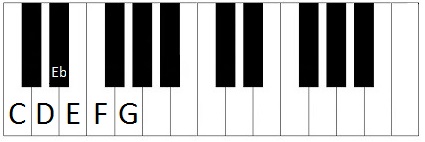Learning to play the blues on the piano is a lot easier than you would think, and a huge part of creating that awesome ‘bluesy’ sound lies in bending the pitch of the notes. To bend the pitch on a guitar for example, you will have often seen the guitarist physically push the string up whilst they play.
But how do you bend the pitch on a piano?
Some keyboards and pianos literally have a pitch bend or bar on the bottom left hand side. It’s basically a small circular function that you can slide up or down, and it also allows you to bend the note a semi-tone right up to a tone (and in between, although will sound out of tune). However, we are not interested in this neat but pointless function for what we want to do.
So without the pitch bar function, we need to somehow bend the pitch physically on the keyboard. And here’s how it’s done –
Take a look at the picture below which is an overhead view of a few keys on the piano.

You will see that we have five notes from C to G and the Eb. Typically in blues piano you would bend from the E flat to the E, or sometimes even down to the D. If you’re playing in the key of C major, then using the E flat is very common.
In order to slide and ultimately bend the pitch of the note, you would take your second finger of the right hand and place it on the bottom edge of the E flat. Play the note and then slide off the bottom right of the E flat onto the E (playing the E straight after). Your goal here is to seamlessly slide from the black note down to the white note, without allowing the sound to lift off.
This technique may seem very strange at first, but you will quickly get used to it each time you try it. And if you’re looking to learn how to play blues piano, this is a technique constantly used and vital if you want to create a blues sound.
Other notes which are great to slide from are the F sharp to the G, or the F sharp down to the F. Again, finger two works really well for the sliding technique, but you can also sometimes use the third finger.
Now, you may be thinking that the slide doesn’t sound so good on its own. Sliding from just one note to another isn’t going to create the piano blues melody you’re after, so here’s a little guide on what you can play to start playing blues piano today.
Here’s a fantastic little exercise to get you started –
Play the C and then play the slide from the E flat to the E (use the middle finger for the slide and the thumb on the C). Do this a few times and you will start to hear a short blues melody forming.
Now play a G after the above (little finger), followed by a return back to the slide (E flat to E) and then finishing on the C below. You’ve now got your own little blues piano riff!
Learn to play piano blues online with me
My online blues course teaches blues piano from scratch and builds your ability in a modular way. As you progress through the course, you’ll learn left hands, right hands, bridges and endings which you’ll use together to make your own blues piano compositions. I’ll show you the blues scale early on, giving you everything you need to start improvising – and we’ll progress to advanced licks and an impressive tutorial song to consolidate your new skills. Finally, we’ll move onto some popular blues songs, including music by the great Jerry Lee Lewis and my own personal favourite, Ray Charles.
I charge just £19.99 for 6 full months access, with 58 videos and counting – that’s less than the cost of a single piano lesson! – and I offer a 100% satisfaction money back guarantee.

Thanks for that I’ll give it a try.
there’s a name for this technique.. herbie hancock mentions it in his masterclass videos but I’ve since forgotten what it is called.